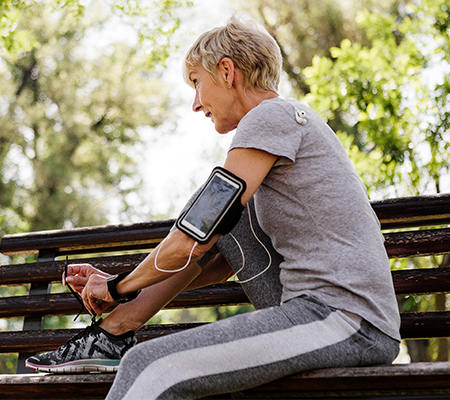Turning 50 is a milestone for many women, and with that milestone brings changes to the body that may not have happened earlier in your life. One of those changes may be how your body responds to an exercise workout when you are over 50, including an increase in fatigue, muscle and joint aches and injuries.

Whether you’ve turned 50 or are on your way, staying fit may bring challenges, but exercise has its benefits. It’s never too late to start an exercise workout program. Once you find the right training and physical activity routine, it’s critical to stick with it.
More benefits than just staying in shape
Exercise and fitness release chemicals that improve mood and sleep and help reduce anxiety. Aging can be stressful and exercise not only makes you look younger, but also makes you feel better inside.
“Exercise slows the normal physiologic changes of aging. It improves mood and your sense of well-being. Exercise also can help manage chronic diseases such as high blood pressure, high cholesterol, heart disease, peripheral vascular disease and diabetes,” said Dr. Chad Giles, non-operative orthopedics specialist at Marshfield Clinic Health System. “It helps reduce the risk of physical disability, increases life expectancy and quality of life.”
It also can improve body composition by decreasing body fat and increasing muscle mass. Resistance training increases bone density, which may prevent fragility fractures, improve balance and reduce risk of falls.
Staying fit as you age
As women age, it’s important to consider transitioning to low-impact activities that decrease force and stress at the joints.
If you’re just starting an exercise workout over 50, talk with your provider, especially if you have risk factors for heart disease, such as smoking, high blood pressure, high cholesterol, diabetes or a family history. As you ease into a routine, remember to start slow, don’t strain yourself and do shorter workouts at the beginning.
“Cardiovascular, pulmonary, metabolic and orthopedic conditions often are cited for stopping exercise as we age,” Dr. Giles said. “Balance or decreased vision also can be safety concerns while exercising. Arthritis is a common orthopedic condition that may cause older women to stop exercising. However, it is extremely important for individuals with orthopedic conditions like arthritis of the hip or knee to continue to exercise to keep their legs and body strong.”
Learn more about staying fit as you age from Barbara Theisen, family medicine nurse practitioner at Marshfield Clinic, in this video.
Keep exercise part of your routine
Every bit of movement counts. If you don’t have time for a full workout, look for other ways to get your steps and movement in during the day, such as taking the stairs instead of the elevator or walking your dog.
“In general, women should be striving for 150 minutes of moderate-intensity aerobic exercise a week, or as much as they are able,” Dr. Giles said. “Therefore, 30 minutes of exercise, five days a week is recommended.”
He also said strength and resistance training should be performed two to three times per week and stretching should be performed before and after every workout.
You may need longer than a day between workouts
Taking a day off between workouts or strenuous activity gives your muscles and body time to recover, but with an over 50 workout, you may need more than one day.
“Soreness is common and may even be the sign of a good workout. To help prevent severe soreness, slowly incorporate new forms of exercise,” Dr. Giles said. “You also should stay well-hydrated. It’s also important to start and end workout sessions with appropriate warm-up and cool-down periods.”
He said if the workout creates pain greater than a four out of 10 on a pain scale, the exercise intensity or duration should be scaled back. If soreness does occur, light exercise, a massage, muscle rubs or balms, ice or heating packs, over-the-counter pain medications or gentle stretching may help.
Rest and recovery days also are important with severe soreness to help prevent injuries.
“Monitor for chest pain, shortness of breath, irregular heartbeats, lightheadedness or dizziness, fainting, ankle swelling, joint redness or swelling, cramping or burning sensations in the legs or delayed and severe onset pain,” he said. “Stop exercising and seek medical attention if you notice those symptoms.”
For help with fitness, talk to a Marshfield Clinic Health System provider.
Schedule appointment Message your provider
Related Shine365 articles
How can you prevent a diabetic foot ulcer?






Leave a Reply